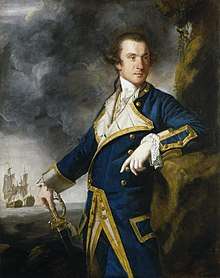HMS Robust
HMS Robust was a 74-gun third-rate ship of the line of the Royal Navy, launched on 25 October 1764 at Harwich.[1] She was the first vessel of the Royal Navy to bear the name.[note 1]
_Marlborough_(1767).jpg) Plan of Robust | |
| History | |
|---|---|
| Name: | HMS Robust |
| Ordered: | 16 December 1761 |
| Builder: | Barnard, Harwich |
| Launched: | 25 October 1764 |
| Fate: | Broken up, 1817 |
| Notes: | Harbour service from 1812 |
| General characteristics [1] | |
| Class and type: | Ramillies-class ship of the line |
| Tons burthen: | 1624 bm |
| Length: | 168 ft 6 in (51.36 m) (gundeck) |
| Beam: | 46 ft 11 in (14.30 m) |
| Depth of hold: | 19 ft 9 in (6.02 m) |
| Propulsion: | Sails |
| Sail plan: | Full rigged ship |
| Armament: | |
Service history

In 1778 she was at the Battle of Ushant in Palliser's division of the fleet. Her captain, Alexander Hood, took Palliser's side in the subsequent court martial known as "the Keppel affair".
Robust was part of the fleet under Lord Hood that occupied Toulon in August 1793. With HMS Courageux, Meleager, Tartar and Egmont, she covered the landing, on 27 August, of 1500 troops sent to remove the republicans occupying the forts guarding the port.[2][3] Once the forts were secure, the remainder of Hood's fleet, accompanied by 17 Spanish ships-of-the-line which had just arrived, sailed into the harbour.[4]
On 12 October 1798 she captured the French ship Hoche while under the command of Sir John Warren. [5]
On 21 July 1801, the boats of Robust, Beaulieu, Uranie and Doris succeeded in boarding and cutting out the French naval corvette Chevrette, which was armed with 20 guns and had 350 men on board (crew and troops placed on board in expectation of the attack). Also, Chevrette was under the batteries of Bay of Cameret. The hired armed cutter Telemachus placed herself in the Goulet and thereby prevented the French from bringing reinforcements by boat to Chevrette.[6]
The action was a sanguinary one. The British lost 11 men killed, 57 wounded, and one missing; Chevrette lost 92 officers, seamen and troops killed, including her first captain, and 62 seamen and troops wounded.[6] In 1847 the Admiralty awarded the Naval General Service Medal with clasp "21 JULY BOAT SERVICE 1801" to surviving claimants from the action.[7]
Fate
Robust was employed on harbour service from 1812, and was broken up in 1817.[1]
Notes
- According to J.J. College's Ships of the Royal Navy, Vol 1, 1987, Naval Institute Press, Annapolis, Maryland there was also a screw second rate laid down on 10 October 1859, but work was suspended 10 October 1861 and the ship cancelled 1872. In volume 2 of this book is described another vessel named HMS Robust, a fleet tug of October 1971.
Citations
- Lavery, Ships of the Line vol.1, p177.
- James (Vol.I) pp. 67 - 69
- "No. 13572". The London Gazette. 16 September 1793. p. 799.
- James (Vol.I) p. 69
- Naval Chronicle (12 October 1798). "The Hoche in tow of the Doris". Royal Museums Greenwich. National Maritime Museum. Retrieved 21 March 2020.
The Hoche was captured by Sir John Warren, in HMS Robust, on 12th October 1798 and was towed by HMS Doris into Lough Swilly, County Donegal, Ireland
- "No. 15390". The London Gazette. 25 July 1801. pp. 918–919.
- "No. 20939". The London Gazette. 26 January 1849. p. 246.
References
- James, William (1837) [1827]. The Naval History of Great Britain, Volume I, 1793–1796. London: Richard Bentley. OCLC 634321885.
- Lavery, Brian (2003) The Ship of the Line - Volume 1: The development of the battlefleet 1650-1850. Conway Maritime Press. ISBN 0-85177-252-8.